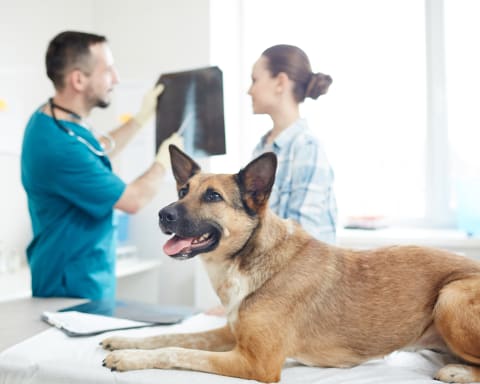The Most Common Dog Knee Injury
The cranial cruciate ligament (CCL) in dogs’ knees can tear, similar to the ACL in people. CCL injuries are common in dogs, so surgery on this joint is the most common orthopedic surgery performed.
These injuries can be caused by acute onset (sudden injury) triggered by a sudden twisting or tearing of the ligament, or chronic onset caused by age, type of breed, obesity, or other factors.
Owners should also know that surgery for a CCL rupture does not repair a knee (stifle) joint, but simply stabilizes it. The injured knee is not as good as new and although it may function normally, the other healthy knee takes on an added burden. This can be a contributing factor to having the CCL rupture in the healthy knee.
If your dog’s CCL fails suddenly, you may hear them yelp in pain, and they may not be able to put any weight on the leg that’s been injured. As the bones begin to rub together, arthritis can set in and the knee joint will not be able to function.
Dog Knee Surgeries and Procedures
There are a few surgical procedures your veterinarian will consider to repair your dog’s torn CCL. Which CCL surgery is right for your dog will depend on his:
- Size
- Age
- Lifestyle
- Weight
- Surgeon’s preference
- Financial implications/cost of procedure
The surgeries include:
Lateral Suture (Extracapsular)
The CCL prevents the tibia from sliding forward and out from underneath the femur. This procedure is performed with the goal of restoring stability to the knee by placing sutures outside the joint to mimic normal activity of the CCL.
For this surgery, a one-fiber (continuous monofilament) nylon suture is placed around the femur’s fabellar bone, then looped through a hole drilled into the tibial tuberosity. A stainless steel clip is used to hold both ends of the suture in place.
To choose the correct procedure, it’s important to diagnose the injury correctly and identify the extent of it, as a CCL rupture leads to knee instability, which can cause damage to other structures throughout the joint. Appropriate diagnostics will also increase your dog’s chances of recovering successfully.
Lateral Suture is not your only option. Alternatives include:
Tibial Plateau Leveling Osteotomy (TPLO)
This procedure changes the angle of the tibial plateau, rotating it so the femur no longer slides backwards and the knee is stabilized. This eliminates the need for the CCL ligament entirely.
Tibial Tuberosity Advancement (TTA) Surgery
This procedure changes the dynamics of the knee so the CCL is no longer needed to stabilize the joint. A linear cut is made along the length of the tibial tuberosity (the front part of the tibia). The bone is then advanced forward, and the open space is filled with a special bone spacer, placed between the tibia and the tibial tuberosity.
A stainless steel metal plate is applied to secure the bone in place.
Potential complications and recovery
Not every dog is a candidate for every procedure. Your vet can inform you about advantages and disadvantages of each surgery, as well as potential complications and side effects. You’ll also receive instructions about recovery. Full recovery from many orthopedic injuries may take up to 6 months.
After-care, including physical therapy and exercise, are key to a safe and successful recovery.
Diagnostics are part of our services. If you think your dog may have torn his ligament, contact our office as soon as possible to schedule an appointment, so it can be correctly diagnosed.
Looking for a vet in Flat Rock?
We're always accepting new patients, so contact our veterinary hospital today to book your pet's first appointment.Related Articles View All
Caring for a Dog With a Broken Jaw
Broken jaws are surprisingly common in dogs. In today's post, you will learn about the most common causes of broken jaws in dogs, how they can be repaired, and advice on caring for your pup as their jaw heals.
What does ringworm look like on a dog?
Contrary to its name, ringworm is a fungus comparable to athlete's foot. It produces infective seeds known as spores, which are highly resilient and difficult to eliminate in the environment. Ringworm may infect the skin of dogs and other animals. Today, our vets in Flat Rock discuss ringworm in dogs and what it looks like.
Cat Laryngitis: What to Do if Your Cat Loses Their Meow
Have you noticed that your kitty's meow has been reduced to a scratchy rasp, squeak or complete silence? Laryngitis in cats can be caused by numerous factors. Today, our Flat Rock vets share more about cat laryngitis symptoms, causes and treatments.
Should I get my indoor cat vaccinated? Why and when to do it
Our Flat Rock vets share some insights about why it's a good idea to have your indoor cat vaccinated against a number of serious conditions and diseases.

